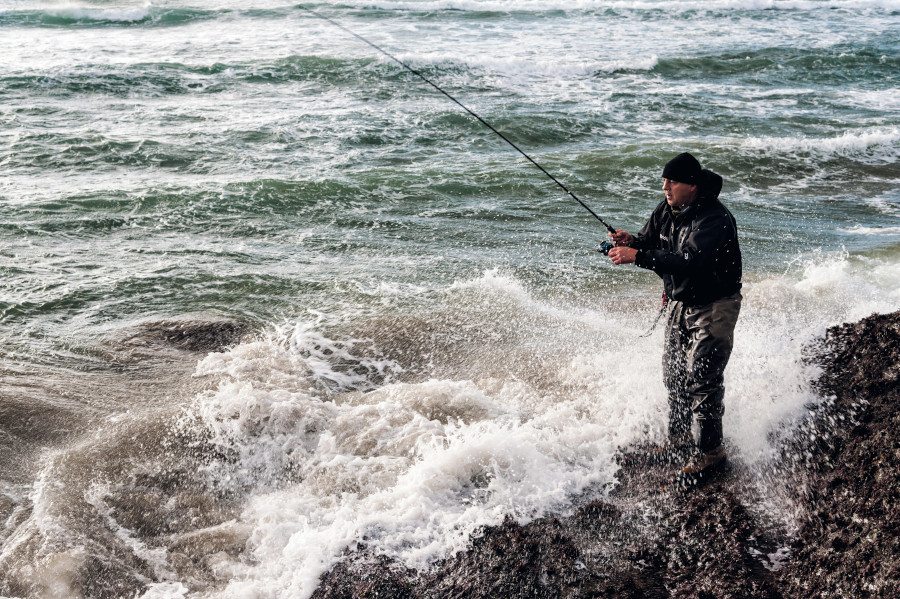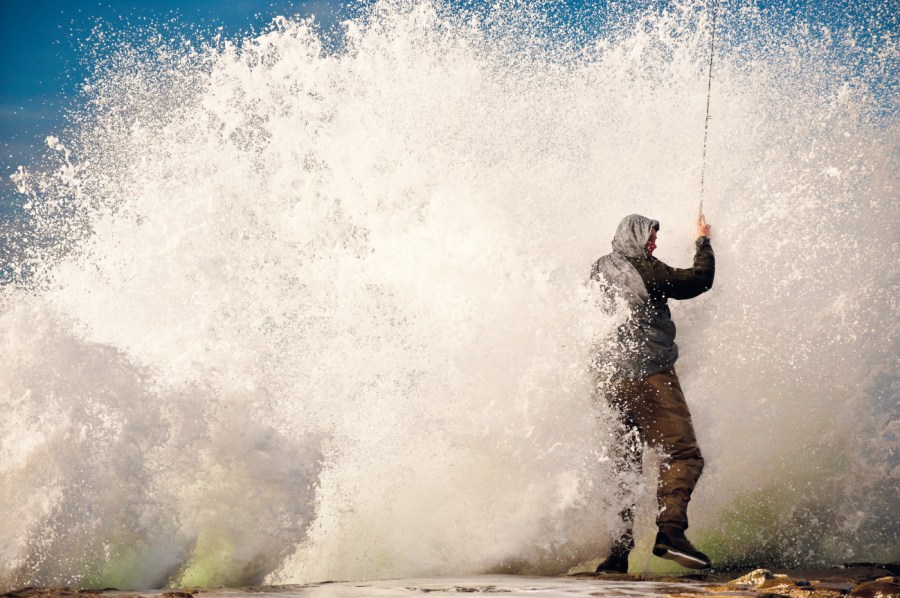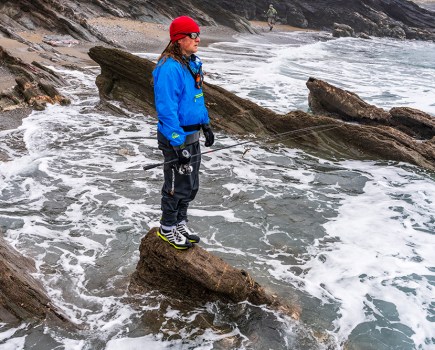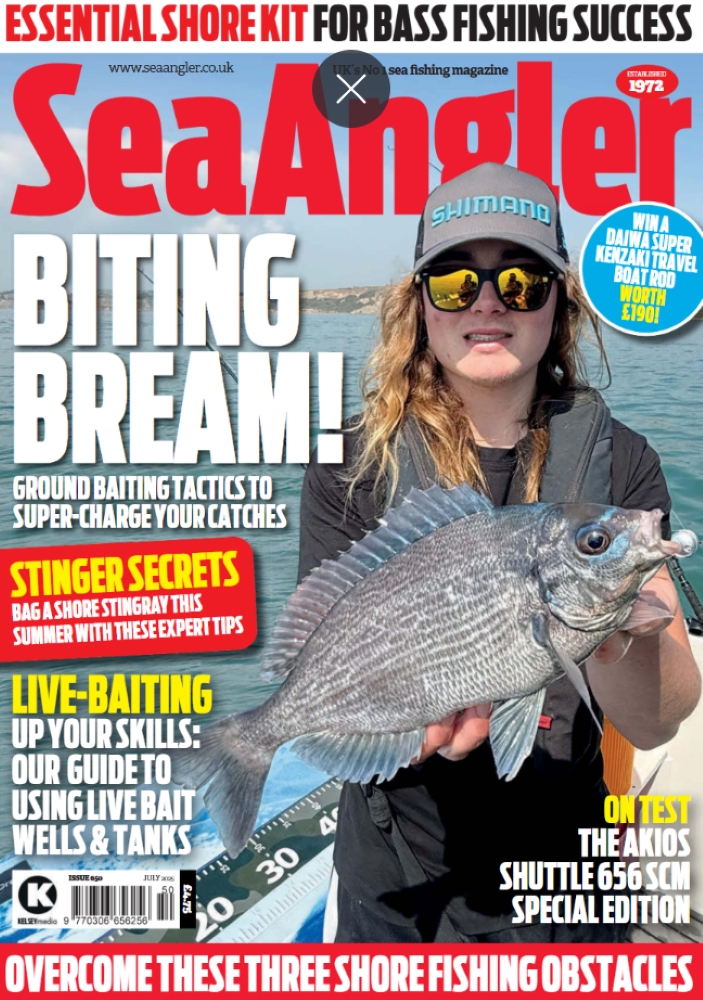Henry Gilbey introduces how to compose your fishing photos and grab the attention of your viewer by using these pro hints and tips
In our first article we had a look at how we might slow down a bit and start thinking more about the fishing photos we want to take. So now let’s take that further and start dialling into composition, or the makeup of the actual photo.
I hope you have been playing around a bit and not just standing there and shooting away at eye-level all the time. I also hope you have noticed how changing the angle or position at which you take a picture can really “grab” you when you scroll through your camera roll – but what about how we might use the elements in front of us to help make an interesting photograph?
How do we combine the angler and all that sea and sky or rocks and sand and waves and so on into a photo that people want to look at?
SUBCONSCIOUS
We need to think about how our eyes look at a photo. You might think you just look at a photo, and in many obvious respects you do, but a photograph which makes you stop and look that bit harder most likely contains various elements which literally lead your eye into the main subject without you even realising that it has happened.
It’s not some weird thing which only photographers know about, but if I showed you say five photos of the same face in the same light and shot in the same way, but one face had eyes that were out of focus, I can guarantee you that your eyes would fly straight by the photo with the out of focus eyes.
We don’t know it, but we look for sharp eyes in those kinds of photos, just as we are drawn to good light or crashing waves or an angler casting or a big fish, of course.
In many respects we have it pretty easy with the photography of fishing, or at least we do when it comes to the subject matter.
We are all anglers and we tend to like looking at photos of fish or people fishing, so the simple act of including a fish or an angler in a photo is already drawing the eyes of an angler to take a look.
This, though, doesn’t hide the fact that a bad photo is a bad photo, rather that we have a good base to work from on which we can think about the composition. Photography is an art form, and unless you only shoot with a 50mm lens which is accepted as the field of view our eyes see then I would argue that most photographs are concerned with trying to create something visually interesting in a way which somebody else might not have seen.
An angler standing on a rock with a beautiful sky behind them might be an everyday thing to many of us who go fishing a lot, but when did the sea conditions and light ever look exactly the same two days in a row? When did another fish ever look quite the same as the one before?
What might look relatively normal to you might look quite extraordinary to somebody who has never been fishing, or who fishes in a different part of the country or indeed the world. Some photos I shot of a fly angler fishing for tigerfish on the Zambezi River in Africa with a herd of elephants behind him might look pretty normal to anglers in some parts of Africa for example, but when did you ever see anything like that?
And when did those anglers who are more used to herds of elephants in the background ever see crashing waves onto a lonely coastline in the middle of a northern hemisphere autumn? All things are relative when it comes to photography, and I would urge you to never take anything for granted.
FRAMING

So let’s imagine your mate is fishing away and you think that the overall scene might make for an interesting photo. Remember last month’s advice before we go any further, but now think about how you might literally “grab” the eyes of the viewer (why else are you taking photos if you don’t want anybody else to see them?).
Whether you are using a mobile phone or proper cameras and different lenses like me, have a look through the viewfinder or at the screen on your phone – that is the frame, or rather that is what space you have to fill with something interesting.
With a mobile phone and a fixed lens, move closer to fill the frame with more good stuff, or move further back for a wider field of view. Some of the more expensive mobile phones have multiple lenses which can make life even easier again, but I would strongly advise against just standing there and pinching in to zoom closer because unless your phone has different lenses you are losing a lot of image quality.
Think about that frame or view and how we are going to cause the eye of the viewer to look at what we are shooting. We often fish in some stunning looking locations, and when the light is good I like nothing more than looking at what is in front of me like a landscape shot, but with an angler in it.
People sometimes ask me what sort of photographer I actually am, so in many respects I think of myself as a landscape or indeed seascape photographer, but because I love fishing I am more often than not putting a human element in there.
LOOK FOR THE POINT OF INTEREST

And that human element also lends a sense of scale to the framing. With lovely light you can very easily compose a photo so that the angler is pretty small in the frame, where you are allowing the sheer majesty of light and location to do the talking.
Correspondingly when the light isn’t very exciting I would suggest moving in closer to the angler or carry on fishing yourself and get your phone or camera out if and when things look better.
The one advantage we do have with saltwater lure fishing especially, is that the sea is often moving in an interesting way, and those waves or a stretch of coastline or the details on a lure can often provide another point of interest to a photo. A grey day can look pretty good if there are waves crashing around for example.
LEADING LINES

Have a think about what are often called leading lines, or the way in which we can use natural features to help draw the eye into a photograph. As much as I think I am shooting landscapes or seascapes a lot of the time, in fact my point of interest in the photo is basically the angler, so how can I better lead your eye into my photograph without you even realising?
If, like we discussed last month, you get down low to shoot up at your mate, you are already causing the viewer to look into your photo, but once again I would urge you to take a bit of time and look around.
Could you use a handy gully to lead the eye into where your mate is fishing for example? Getting down a bit lower and framing the angler against an impressive looking sky tends to be pretty powerful as it is, so bearing in mind that we want the angler to so often be the focal point of the photo, firstly he or she needs to be in focus, and secondly, try to be conscious of not “losing” your mate in a background.
We often wear fairly dark clothing for our fishing and this can result in an angler almost merging into, say, a rocky background if you are not careful. Again though, we have the ability to move around and better compose the photo so that this doesn’t happen.
FILL THE FRAME

Don’t be afraid to fill the frame by the way. If the light and seascape look good I do love to shoot wide angle photos when I can, but it takes a technically good photo to retain interest when everything is so small within the frame.
I would urge you to think about using all that lovely space within the frame and filling it up with interesting stuff more often than not. Don’t be lazy and fire away and simply crop your photos down later on. The more you crop, the more pixels you lose, which will harm how good your photos can look if you ever come to print them at a decent size or use them in a photo book.
Does the angler you are photographing need to look like they are miles away and the eye soon loses interest because you haven’t filled the frame with enough to hold it?
Note that I have not yet talked about photographing the fish that you or your mates might catch, because that is a big subject on its own and we will get to it soon. You also need to note that I shoot a lot of fishing photos and I would never try to claim that they are all amazing photos – not at all in fact!
I often need to take a particular photograph because it helps to illustrate something within an article I might write, but I can assure you that I still get horribly overexcited when every single thing comes together to be able to shoot an awesome photo. Fishing is no different to photography; sometimes it happens and sometimes it doesn’t. When it does come together, think about that frame and what you can do within it.







